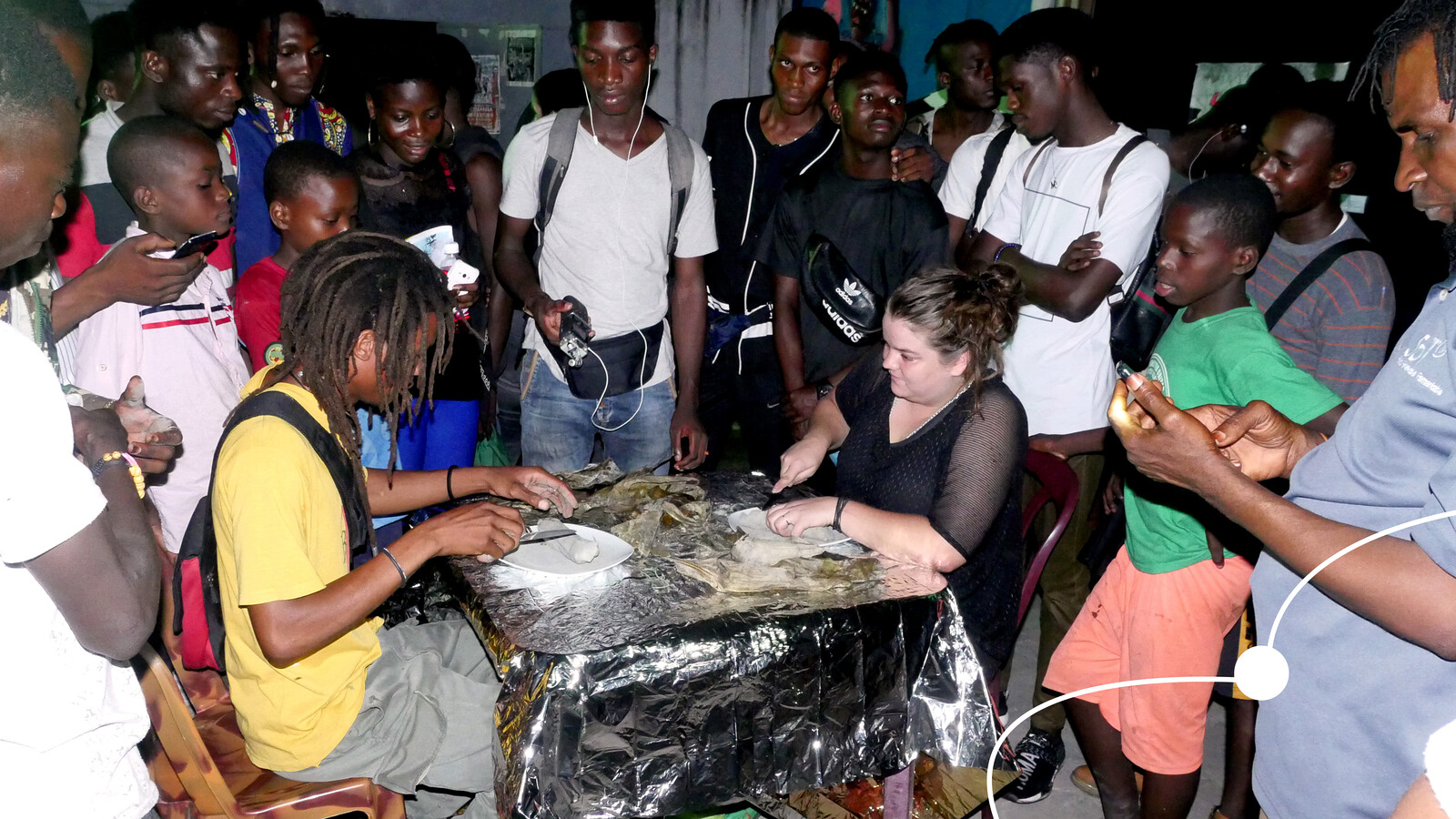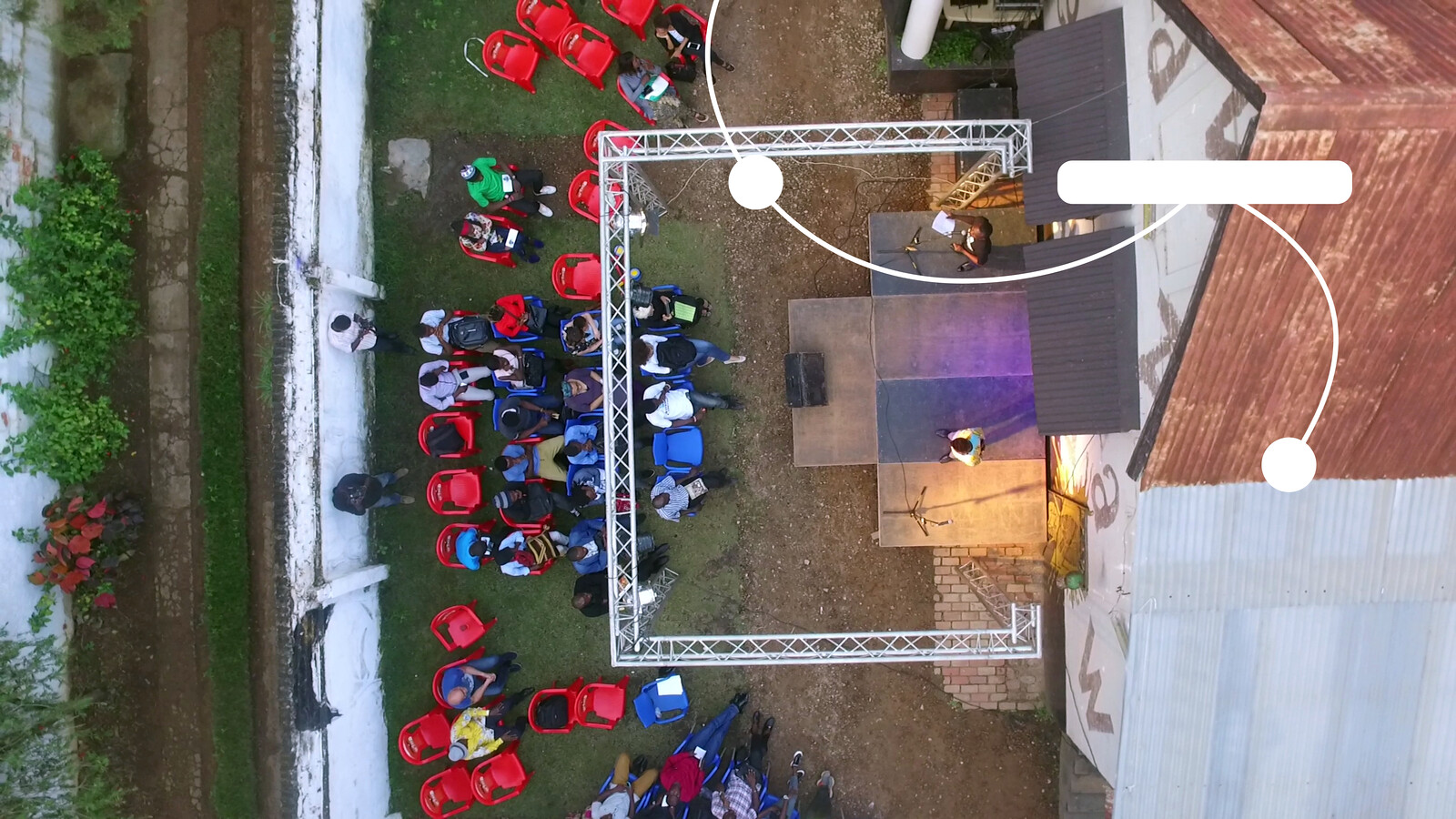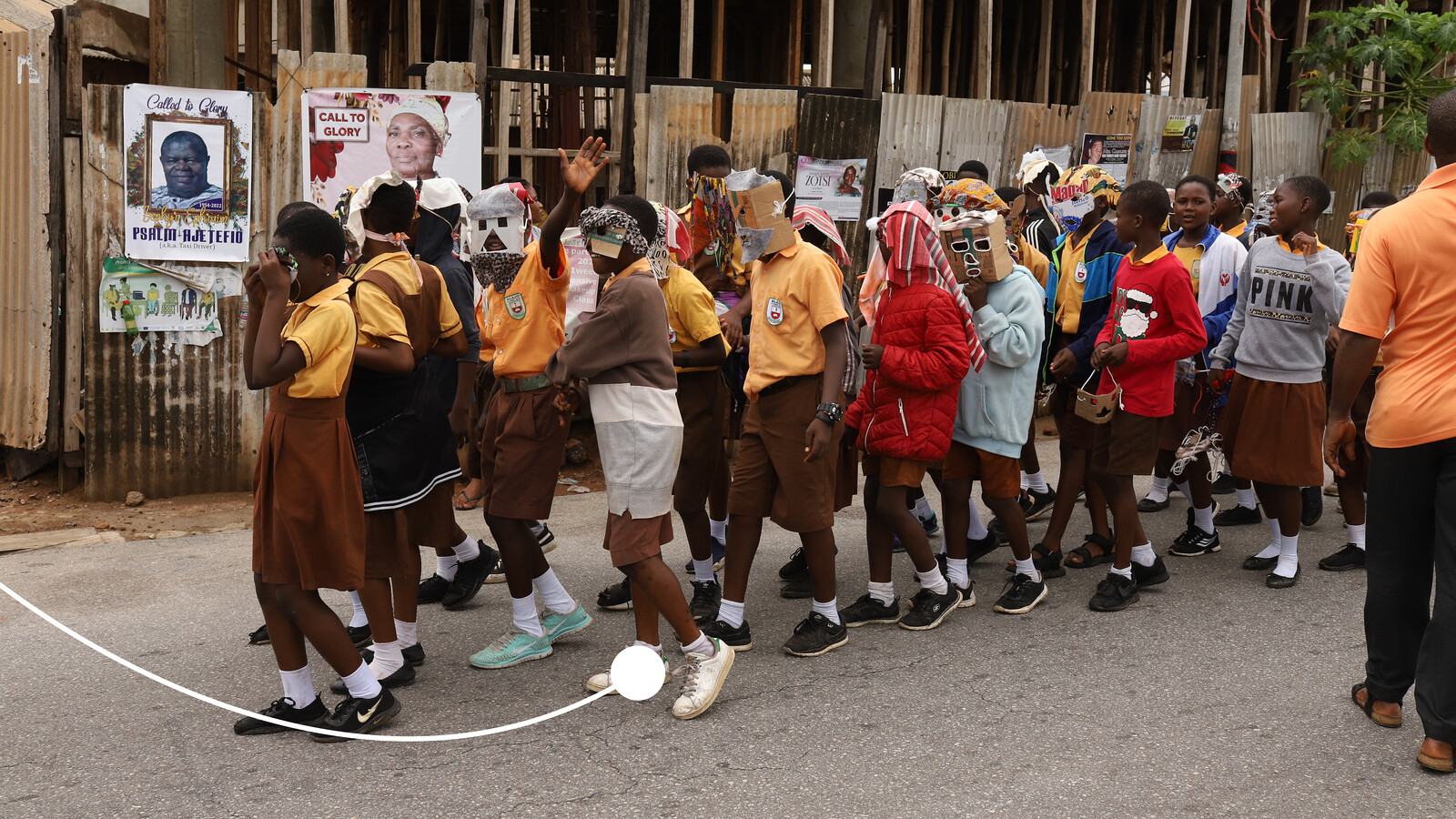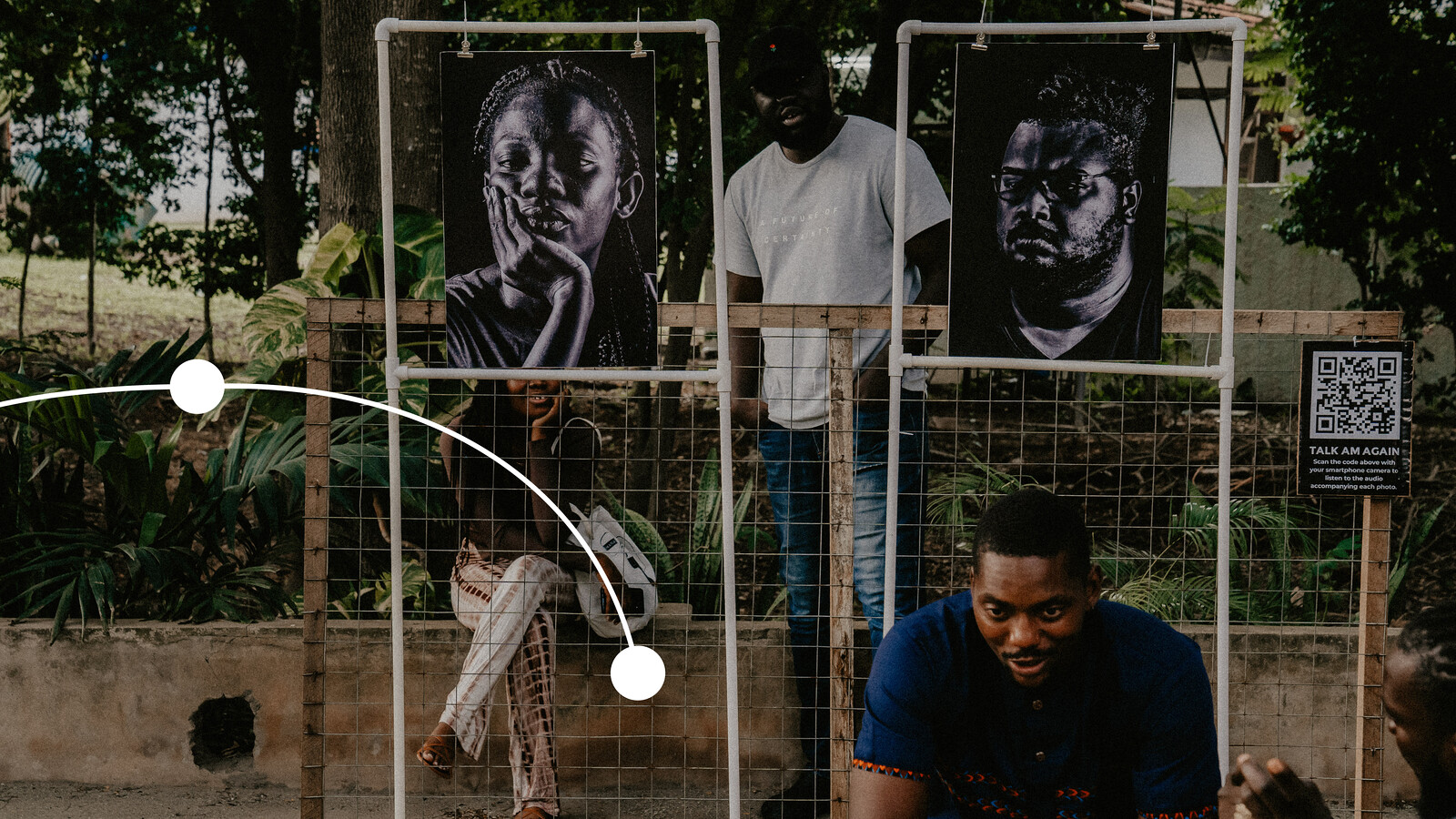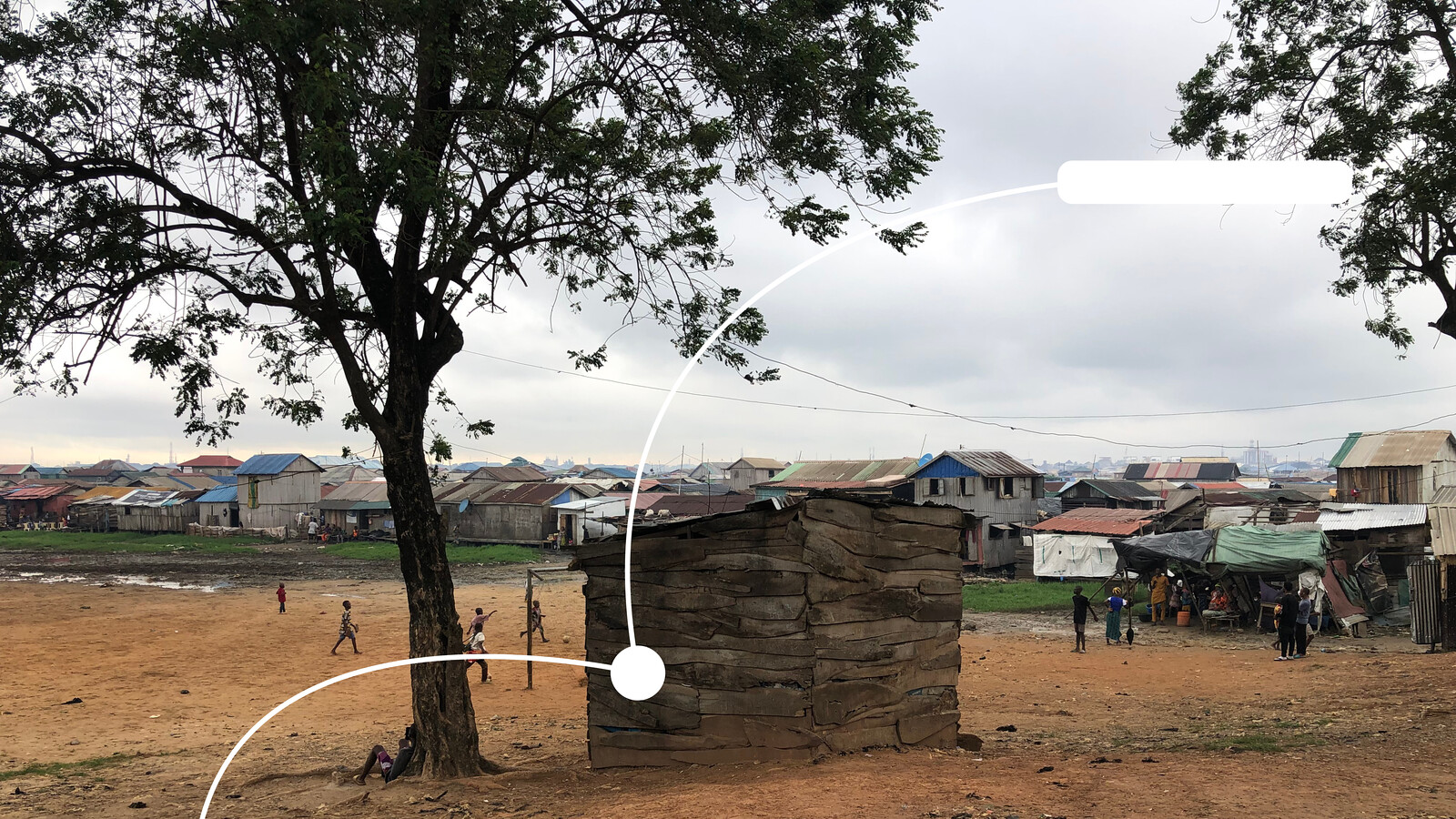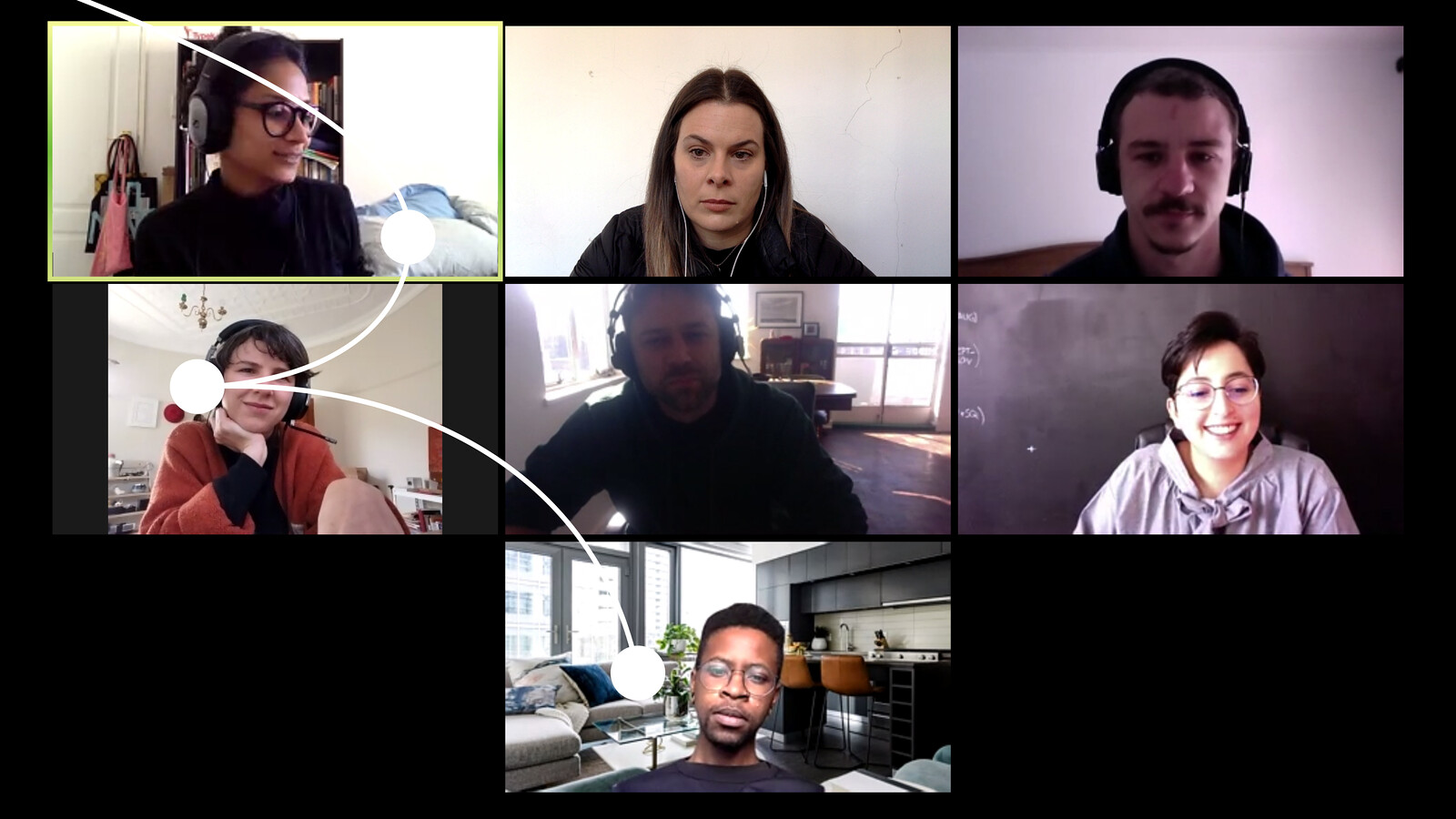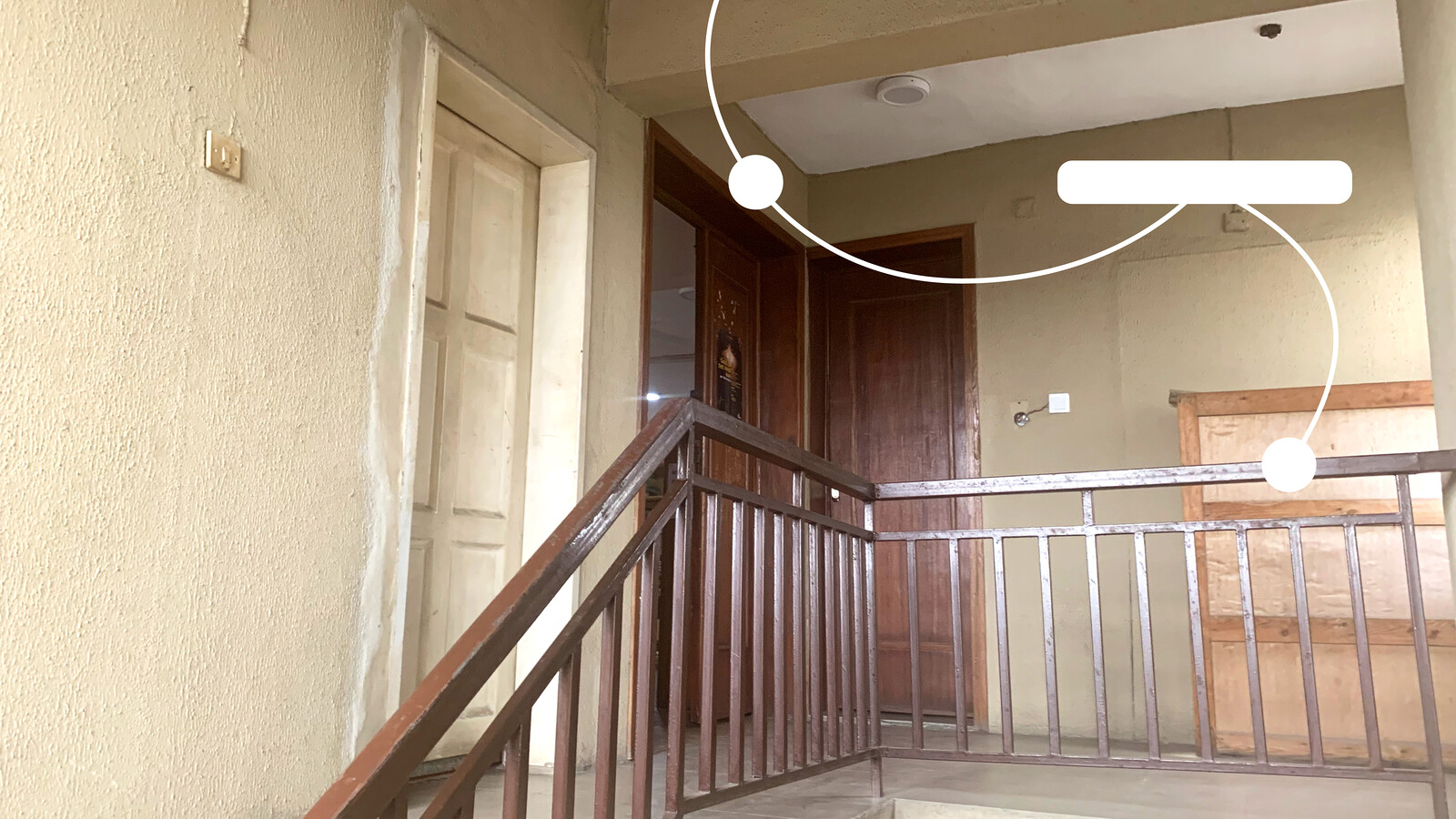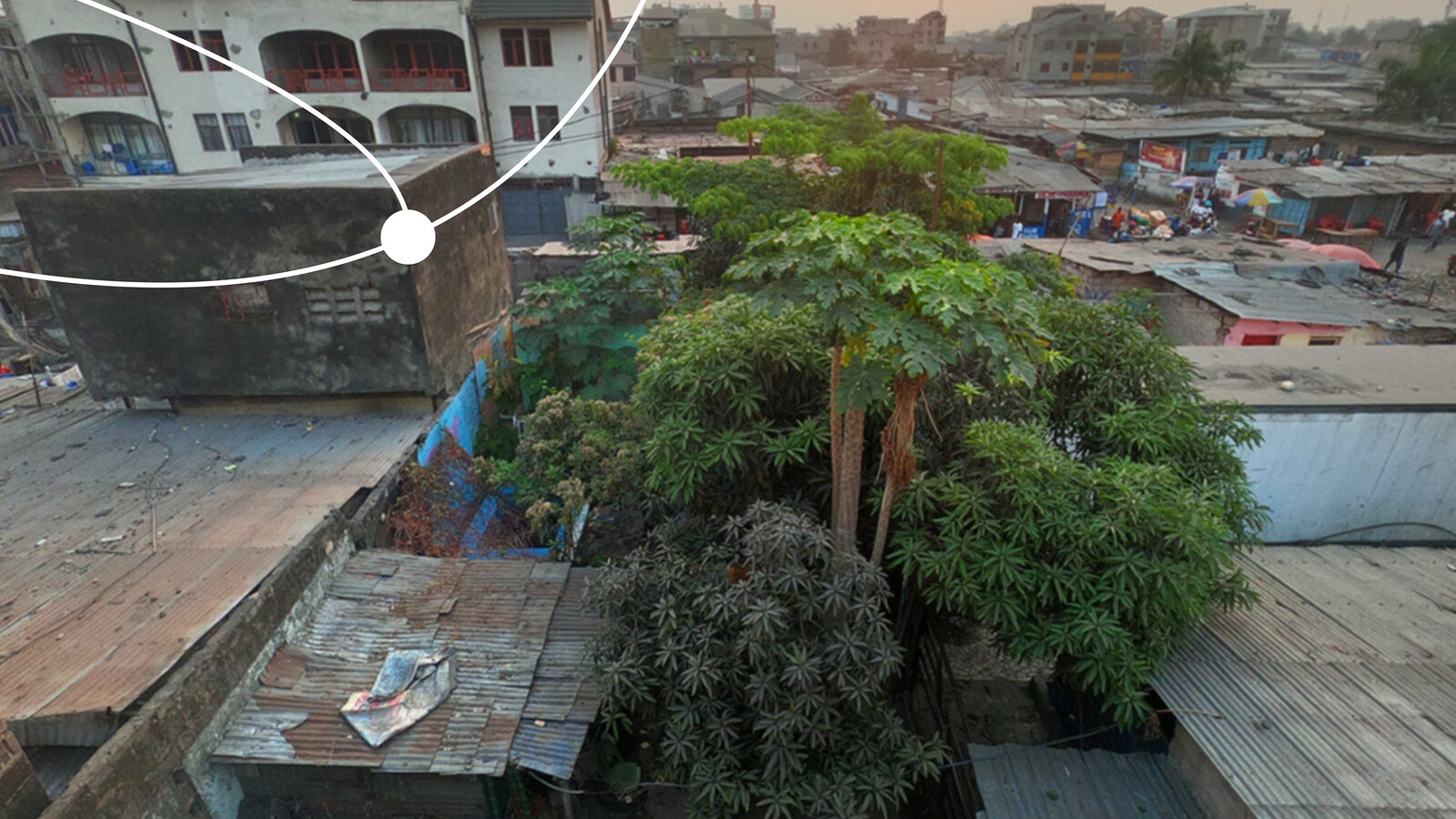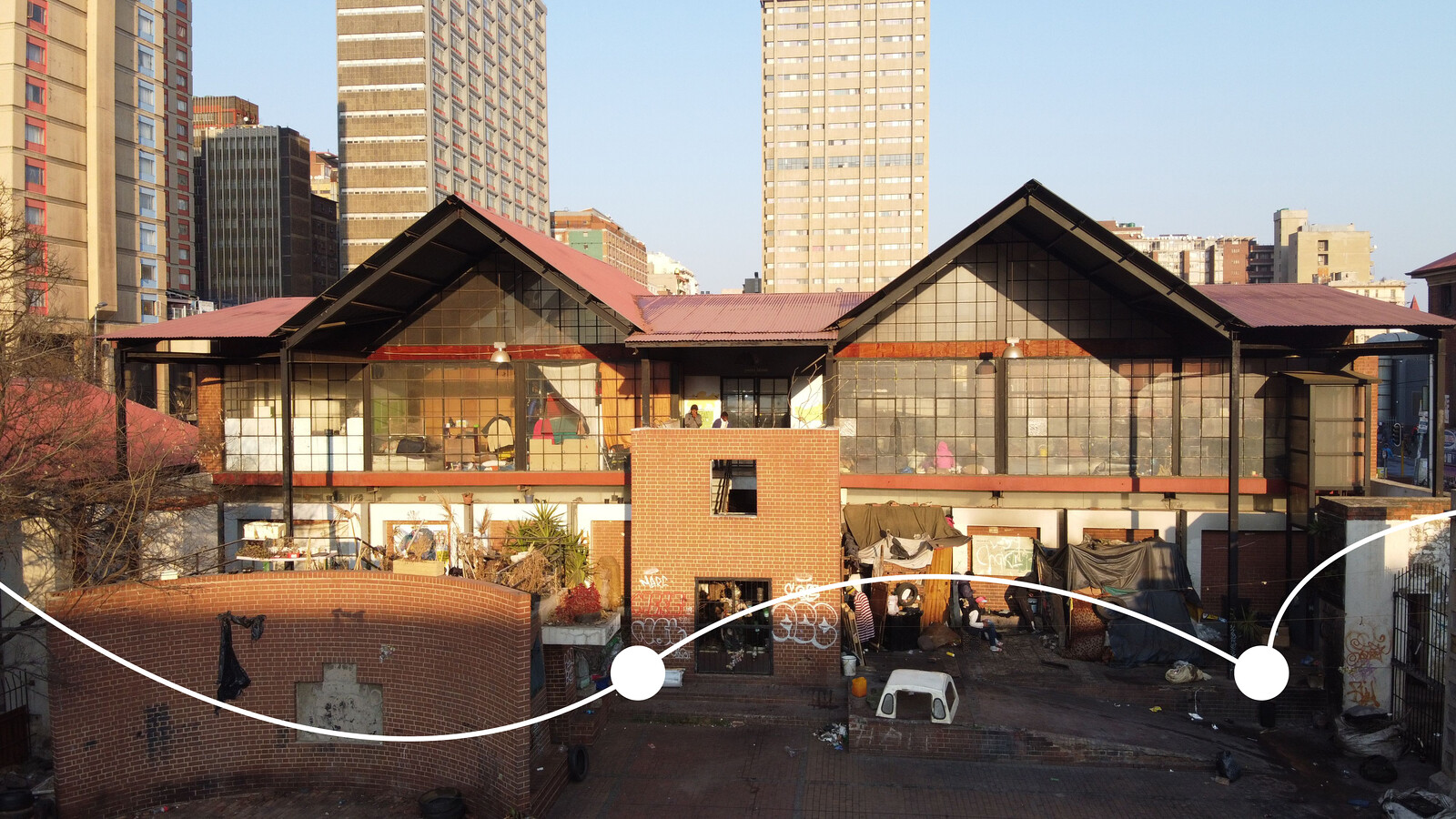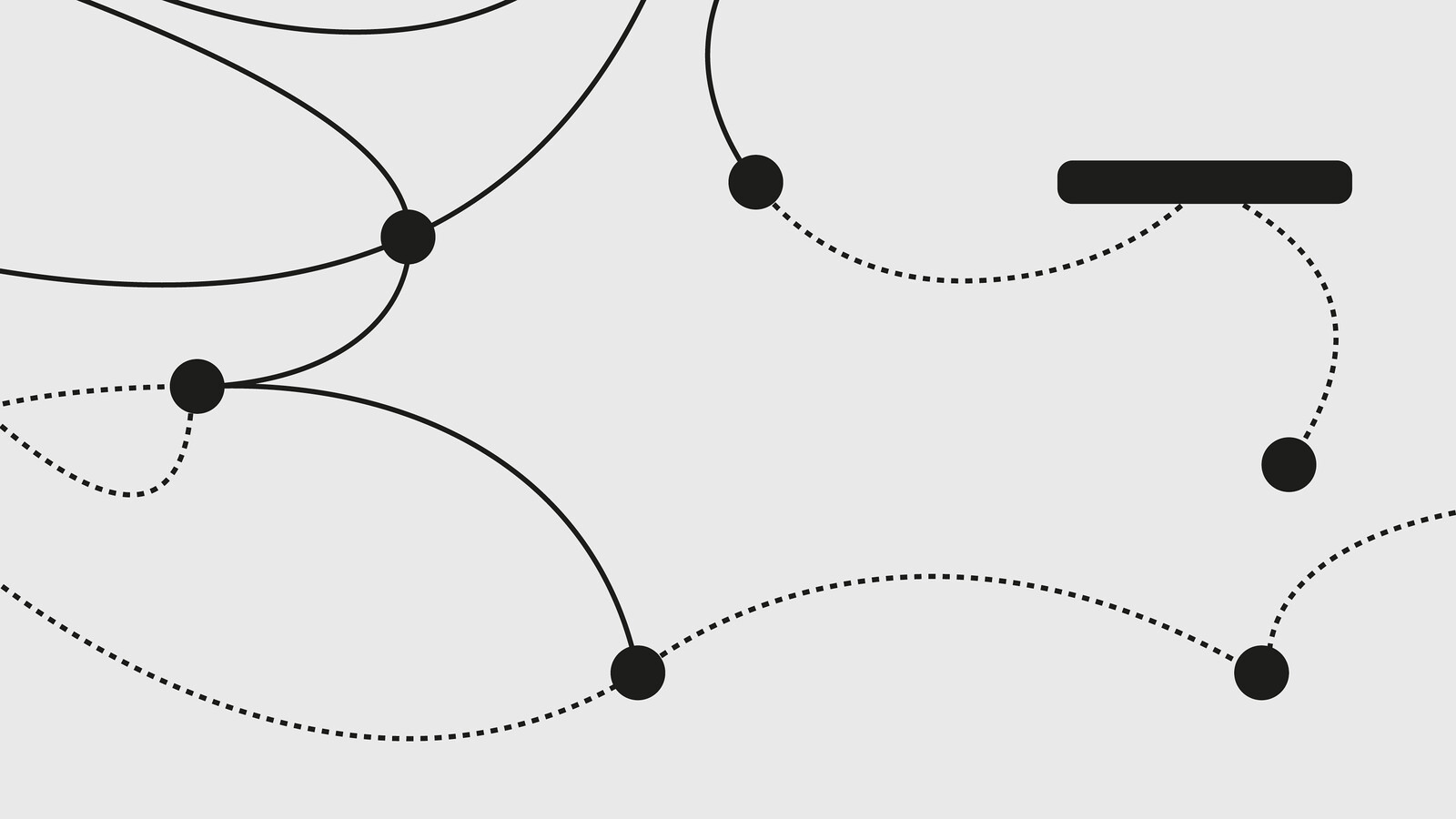Sorana Munsya: Lydia, you’re from Germany, and Christ, you are from the Democratic Republic of Congo. Since 2016, you have officially been working together as an artist duo. Your artistic practice is based on digital and analog paintings and drawings, experimental videos, and performances influenced by painting traditions such as the congolese academism of the first two decades of our millennium and its counter movements like the “Peinture Populaire,“ urban performance movements in Kinshasa, international psychoanalytical approaches of Surrealism and Expressionism, as well as contemporary popular culture. From my point of view, your way of producing art in Kinshasa and circulating it creates surreal situations by breaking down the boundaries that separate social, geographical, and conceptual realities that coexist in the same space of the city. Could you tell us how your duo came about?
Christ Mukenge and Lydia Schellhammer: We met in 2012 in Kinshasa. Lydia came here as a volunteer for a Congolese NGO. A friend introduced us because he knew that we had roughly the same idea for an art project with young people from underprivileged backgrounds. We developed an initial project together for the youth, which went well, so we decided to continue. Following that, we created On Your Own Project and then Urban Museum.
SM: What did OYO Project consist of?
CM+LS: It was a social project conceived of in artistic terms. We invited youth from neighborhoods with high rates of unemployment and without schooling and introduced them to art. OYO Project functioned like an informal school. We organized artistic and creative workshops for youths with difficult family situations. We also provided them with food and could offer medical assistance if they were ill. The project still exists today, but now there are other artists who are running it.


Map of the exhibition venues of Laboratoire Kontempo, 2019.
SM: And how did OYO Project unfold in space? Did you have premises?
CM+LS: OYO Project has always been a nomadic project. At first, we worked in several different public spaces. But after a while, working in the street became dangerous because the police wouldn’t let the youth assemble in public. Young people also had a hard time staying focused in open spaces. Working on a painting, for instance, is complicated in a context where there are a lot of stimuli.
SM: Is that the reason you moved the project into more enclosed spaces?
CM+LS: Yes. We started being able to use a place on the campus of the Fine Arts Academy in Kinshasa. But when the management changed, we had to relocate within a few days and find a new place. We got together with “Double Vision,” at Wilfried Beki (alias Lova Lova) and Lucille de Witte’s place. They were organizing cultural activities at that time in Lova’s grandfather’s building that was under construction, so we continued OYO Project’s activities there. Next, we took over the premises of Bomoko Connexion, an independent cultural space in Bandal, one of the popular areas of Kinshasa. Both spaces were organized and financed by artists. After the two places closed, we moved once again, this time to the children’s center Likemo.
SM: For some, this experience of moving from one place to another might have been a constraint, but for you it seems like it was an opportunity.
CM+LS: The nomadic nature of OYO has taught us a lot and enabled us to develop many strategies for developing artistic work in public space and in networks with artist initiatives. It was on the basis of these experiences that we created the Urban Museum, a project that exhibited artistic works that were made by professional artists and youths with OYO Project in urban space, the majority of which were mural paintings. We did three editions of Urban Museum. The artists in the first edition were the youth and ourselves. Then, for the next two editions, we also invited other professional artists, including Godelive Kasangati, Bouvy Enkobo, Sinzo Aanza, Mega Mingiedi, Prisca Tankwey, and Chéri Benga. We also organized debates and talks, namely with Jean Kamba, Nioni Masela, and Marian Kaiser. We could say that Urban Museum was like a rough draft for Laboratoire Kontempo.
SM: How do you understand the progression from OYO Project to Urban Museum?
CM+LS: With OYO Project, we made mural paintings in public space with the youth. That presented constraints for sure, but also opportunities, because we often created large format paintings and were able to use the city as an exhibition space. With Urban Museum, we continued to do mural painting, but also open workshops and organized studio visits with artists in the city. The combination of activities at that time allowed us to outline our first reflections on decentralization and on the displacement of exhibition spaces from the city center to the neighborhoods. This also led us to address a public like the “expatriates” and bring them to public housing areas.1 They usually only go to the French Institute and other foreign institutions to be in contact with art, but thanks to Urban Museum, they were taken to places where art is actually made. For most of them, it was the first time they had ever walked around a local neighborhood in Kinshasa, besides Gombe.2 We connected them with people in the neighborhood, with our mural paintings made with the youth, and with other artists, including musicians and local performers. In its final version, Urban Museum put on open-air exhibitions and established an urban circuit of artist studios in the districts of Gombe, Bandalungwa, Kintambo, Kasavubu, Barumbu, Limete, Mont Ngafula, and Lingwala, near the Fine Arts Academy of Kinshasa.
SM: What is the connection between your projects and the Fine Arts Academy?
CM+LS: The academy was a meeting point where debates and discussions took place. Furthermore, some students from the academy took part in our projects, either by being part of the circuit of artist studios or by creating works for the open-air exhibitions. In addition, at the Fine Arts Academy of Kinshasa, there was a place called the Noyau (“Core”). For several years, the Core was a squat for students studying at the academy, recent graduates, and other artists who lacked housing, as well as a space of reflection that was independent from the official courses of the academy structure.
SM: Was it allowed by the management?
CM+LS: Well, not officially. There were tensions between the institution—with its regulations and principles—and the rather free structure of the Core. But within that space, artists who wanted to think and produce in another way really made their mark on the academy. Several artistic movements, like Librisme, Kontempo, and Partagisme, were all created from within the Core. These movements, all of which were opposed to Congolese academicism, sought to discuss issues related to the role of art in society and the freedom of art, but also the positioning of art internationally. The fact that those movements arose on the campus of the academy became the subject of many controversies. There were many debates between artists loyal to the academy and those who were involved in these movements. Both sides accused each other of being influenced by Europe. The academy, founded by the Catholic priest Marc Wallenda, was accused of perpetuating colonial teaching. The movements, which had developed experimental working methods and were operating outside the classical framework of Congolese academicism, were accused of being too close to European artistic currents. Performance, nudity, spontaneous urban interventions, painting without accurate proportions or correct anatomy, collective work, and challenging authorship were all not recognized by the academy as true art.
SM: What was your relationship to the Core?
CM+LS: Christ squatted there for several years, and we worked there with OYO Project and Urban Museum for about three or four years. It was one of the key places where the young artists with whom we collaborated could show their work to an audience of other artists with a strong critical mindset.
SM: Does the Core still exist?
CM+LS: No, the new management of the Fine Arts Academy closed the space.
SM: After Urban Museum, you started Laboratoire Kontempo. What was the process of moving from one to the other?
CM+LS: One could say that Laboratoire Kontempo responded to the internationalization of the Urban Museum. We started Laboratoire Kontempo at a time when Urban Museum was beginning to expand with more partnerships and was taking a more official form. Furthermore, Laboratoire Kontempo developed when we began to seriously think about displacement and the context of artistic creation outside of European institutions in Kinshasa. We wondered how to make things outside of the usual framework that we were familiar with. Laboratoire Kontempo also arose from the awareness that there were many independent spaces in Kinshasa that were run by artists or cultural players, but that weren’t taken into account or taken seriously. For instance, we worked for a long time with Bomoko Connexion, which was a cultural center. But when a German volunteer wrote about OYO Project, she described Bomoko Connexion as a backyard. In fact, she told us afterwards that she didn’t consider Bomoko Connexion as a cultural center because the owner of the center lived on site. For her, it was a mix between a home, a garden, and a squat… The idea for Laboratoire Kontempo was to take advantage of those spaces that already existed and that already had their public, their activities, their programming… The aim was really to enter into what artists from Kinshasa were doing and gain an understanding of the local scene from the point of view of the local public.
SM: Was it about returning Kinshasa to Kinshasans through art?
CM+LS: Yes. Kinshasans themselves don’t take advantage of what their artists do. We asked ourselves how to do things in Kinshasa when the people living there don’t know what we’re doing. Our desire was to work with what was already there. We didn’t want to impose European ideas on people, but rather reinforce existing local activities by respecting the local context. We also wanted to think about the relationships between local initiatives and funding institutions, and the effects those relations can have on the artistic decisions of the initiatives in question. One of these effects is the phenomenon of self-exoticization, which is a kind of strategy that entails presenting oneself and saying what corresponds to the other’s image of us. In other words, knowing what the funding structure expects of them, the local structures and local artists behave accordingly.
SM: The notion of presence is important here. More is said about a projection of the other in the present than a projection into the future. In reality, it’s about delving into the Western context to be able to improve one’s own context or one’s own present. Independent initiatives have this very strong ability to read the other’s present; to read the other so deeply that it’s possible to decipher their code…
CM+LS: Yes, self-exoticization is a way to get power back and analyze Western contexts to such an extent that it’s possible to manipulate it. You might grasp their context, but they don’t understand yours, since they haven’t made the effort. This dynamic can also be accounted for in the way the city of Kinshasa is structured. More than anywhere else, the city separates; it separates the city center from the periphery, it separates the bourgeois places from working-class areas; it separates white people from black people. It interests us to think about the way the city influences our “mental architecture,” our psychology. That’s why we always try to make things commingle: putting one context into another and vice versa. For example, we took some youths from Oyo Projects to the French Institute of Kinshasa, which they would normally not be able to enter because they look dirty, because people say they behave badly, that they’re drunk or high… When we first tried entering with them, they were denied access. But after creating projects with them, they were finally able to enter, as artists.
SM: Why was it important for you to take the youth to the French Institute?
CM+LS: We wanted to show those young people that it was possible for them to gain access to that kind of space, spaces that habitually turn them away.
SM: In a sense, you don’t really activate poor neighborhoods, but rather activate movement in the city. It’s as if you were seeking to shatter the structure of the city…
CM+LS: That’s a good way of putting it. We were trying to take things in another direction while making sense of the context. It’s creating movement, and it must be said, this movement creates extreme encounters.
SM: How do you see Laboratoire Kontempo within your artistic trajectory?
CM+LS: At a certain moment, we wanted to pursue work outside of a purely social context, while remaining tied to Kinshasa. That’s why we continued our collaborations with Kinshasan artistic and cultural platforms such as Bomoko Connexion, Platforme Contemporaine, and Double Vision. One of the first collaborative projects with these three structures was a collective exhibition. The exhibition didn’t have a theme from the outset. Rather, we wanted to create a platform for presenting everybody’s work, which raised questions about the impact of the context of Kinshasa on our artistic activities and thinking. Furthermore, working in tandem and coming from different continents, we wondered how we had managed to cope with all these intercultural problems tied to power dynamics. It was necessary to create a platform that enabled artists, including ourselves, to work freely, away from the cliches and stereotypes that local institutions impose. We had often felt that artistic quality is lacking because people work on subjects that don’t concern them.
SM: What kind of subject would the artists work with but not be really connected to or concerned about?
CM+LS: Cliches about poverty, child soldiers… More generally the representation of Congolese women and men as powerless or needy victims, but also intercultural friendship, environmental issues. Some Congolese artists were working with these subjects because they knew it could appeal to international partners and therefore bring funding or other kinds of support. That’s why we created a platform to fund artists and offer them freedom in the themes they wanted to develop in their work.
SM: How did you continue after that first experience of creating a non-thematic exhibition in 2019?
CM+LS: During the Covid pandemic, we decided to do an online exhibition, which allowed us to make an archive. This was done in response to the observation that online content about art on the continent was dominated by platforms from outside the continent. It was important to provide new opportunities for artists from Kinshasa to control the representation of their work online. In 2020, the project also took on a much more collaborative form. Jean Kamba was the one who believed that creating an archive enabled art made in Kinshasa to be accessible to Kinshasans, to Congolese, to Africans. Prisca Tankwey and Paulvi Ngimbi similarly pushed for organizing an exhibition at the Fine Arts Academy.
SM: How else did the pandemic impact your practice?
CM+LS: The pandemic pushed us to assert ourselves in digital space, which raised the question of creating digital works. Paulvi Ngimbi, for example, created new digital room installation; Prisca Tankwey filmed her performance so that it could exist in a virtual exhibition; Sinzo Aanza created digital collages, etc. We ourselves developed a 3D painting practice in virtual space.
SM: Tell me about this project you have called Kinzonzi.
CM+LS: The Project Kinzonzi was a collaborative project with ACUD MACHT NEU, an initiative that describes itselves as one of the “last independent art houses” in Berlin. “Kinzonzi” is a word in Kikongo that refers to the action of getting together because there’s something to discuss. It’s related to the idea of consultation, of group meetings, the purpose of which is to come to an agreement. In contemporary Kinshasa, this term now refers to the construction and elaboration of codes between members of the same group. What was interesting for us in the artistic context was to ask ourselves how artists could reappropriate this contemporary practice of Kinzonzi.


Radio Kinzonzi, Jasmina Al-Qaisi, Ralf Wendt, and Orakle Ngoy at the vernissage of Laboratoire Kontempo Kinzonzi, Haus der Statistik, Berlin 2022.
SM: Can we say that the Core at the time was a Kinzonzi?
CM+LS: Yes. There was also a kind of initiation before gaining access to what the Core provided. Somebody had to bring you in. Without the “initiation,” it was actually difficult to get access, to know the codes, or even understand the structure and the way the Core worked.
SM: So your project Kinzonzi entailed recreating these gatherings between artists?
CM+LS: Yes. The purpose was to create a secret space of exchange between artists and theorists. The group decides what perspectives get unveiled, but the meetings have taken place via exhibitions, public debates, websites, and Radio Kinzonzi.
SM: Can you give an example of a Kinzonzi theme?
CM+LS: We have been thinking about the use of terms like “performance” or “installation,” which are part of the international contemporary art vocabulary and have, in a certain way, defined the world of international contemporary art that artists have to integrate into. The point of this reflection was to observe the function and appropriation of these terms in Kinshasa.
SM: If you had to make a connection between Kinzonzi and OYO Project, what would it be?
CM+LS: The common point between all our projects is the idea of creating unusual encounters, of making people leave their comfort zone, to disrupt what seems to be the order of things.
SM: Has your vision of Kinshasa changed? In other words, after all these projects, do you perceive the city differently?
CM+LS: To us, Kinshasa is a structure of lines, a mental cartography. These lines stretch between the places and people who have had an impact on our work and together form a network. There is always an element of chance when you create unusual encounters. We create these situations without knowing what is going to happen, without knowing who we’re going to meet. A change of place is also always a change of perspective. Through this, we have met people with whom we never would have imagined doing working with, like Maman Béa.
SM: Who is Maman Béa?
CM+LS: Maman Béa is a traditional healer who sells all kinds of things: plants, roots, animal skins. We were neighbors, so she had her stall nearby our place. Once, we noticed a leopard skin on her table, and asked her about it. Maman Béa made a connection between the leopard skin and luxury brands like Gucci, Louis Vuitton, Versace. To her, the leopard skin, which was traditionally used as a symbol of power and a spiritual tool of leadership, has now been replaced by clothing brands. This idea corresponds really well to our works on contemporary mythologies. The conversation was so interesting that we ended up buying this leopard skin and we invited Maman Béa to do a collaborative work.
SM: It’s interesting that you mention people when we speak about Kinshasa’s urban architecture… Do people make the space?
CM+LS: Yes. In Kinshasa, there are lots of people who have interesting things to say, but they don’t have the space or the interlocutors to explore their ideas and put them into practice. People become places for us when they are points of reference. In Kinshasa, most places have several functions. The academy campus, for example, is at once a squat, a workspace, and a meeting place. A cultural center is at once a living space, a worksite, an exhibition space, and a learning place. Places can thus be transformed; they can even switch functions several times a day or overlap. People are what determine the meaning of places.
SM: Could we say that Maman Béa is a place?
CM+LS: Yes, Maman Béa is a place. For us, a place is often a person, because the person produces the same meaning in many places. The meaning of place moves with people, and can also be applied to many different places. People often change places and we follow them… It’s they who structure space in Kinshasa.3
This is what Europeans and Americans who live temporarily in Kinshasa are called.
A residential and commercial area in the city of Kinshasa, Gombe houses the main organs of power in the Democratic Republic of Congo, including the official residence of the president at the Palace of the Nation and the Central Bank, as well as many ministries, media, and diplomatic corps. It also hosts the principle financial institutions, business center, and the headquarters of the Mission of the United Nations Organization in the Congo.
Shortly after the interview, the supporting structure of Laboratoire Kontempo, the non-governmental organisation Option ONGD, opened the cultural centre “Mokili na Poche” (The World in the Pocket). Most of the activities of Oyo Projects and Laboratoire Kontempo currently take place there.
Interdependence is a collaboration between e-flux Architecture and OtherNetwork, a project by ifa (Institut für Auslandsbeziehungen) together with cookies.
Category
Translated by Susan Power
